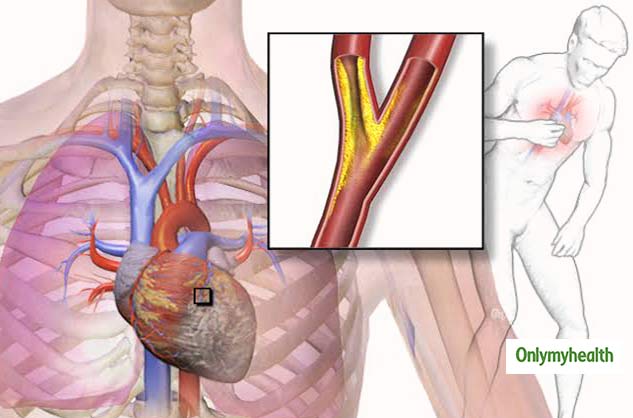
Angina is a type of chest pain that is caused by reduced blood flow to the heart. Angina is a basically a sign of a coronary artery disease. Angina which is also called angina pectoris, causes squeezing, pressure, heaviness, tightness and pain in your chest. The symptoms of this condition vary from person to person depending on the severity. Angina is a major sign of heart disease. Some people with angina symptoms even say that it feels like a tight squeezing in their chest and there is also a sudden heaviness, especially whenever they lie down. Therefore, whenever you feel any kind of persisting chest pain, it needs to be checked by a doctor for further medical treatment. Onlymyhealth editorial team spoke to Dr. Amit Bhushan Sharma, Cardiologist, Paras Hospital, Gurgaon, about angina. Therefore, read further to know details about the types, causes, symptoms, diagnosis and treatment for this heart condition.
Table of Content:-
Angina types
As per Dr. Amit, classically, the patient will say that there are two types of angina, namely stable angina and unstable angina:
1. Stable angina

Stable angina is when the patient is okay at rest but when the patient starts to do physical work like climbing up the stairs or walking uphill the patient experiences discomfort in the chest. He is not able to localise where the pain is emerging from instead it radiates from all of the chest and the moment he starts resting it becomes better.
2. Unstable angina
In unstable angina, the patient will experience pain even when resting. Another term is called as angina equivalent. It means that if you are diabetic or a female or an aged person, then you do not have the classical symptoms of chest pain. It could be sweating in cold weather, uneasyness, palpatations, shortness of breadth and acidity.
Also read: Cardiac Resynchronised Therapy Is Life-Saver for Arrhythmia Patients, Read Details
Angina causes
Dr. Amit Bhushan said, "It is caused because of blockages in the heart arteries. So, when the heart arteries get blocked, the supply decreases and the demand is high. Therefore, as a result, the patients start experiencing chest pain." The main cause of angina is blockages in the heart. Blockages in the heart are majorly caused because of high cholesterol or because of poor lifestyle and also due to other reasons such as diabetes, smoking, stress, lack of sleep and hypertension. One has to maintain a healthy lifestyle and control negatively ffecting factors such as smoking, diabetes and stress, to protect themselves from serious health problems. A poor and sedentary lifestyle is one of the major causes behind angina.
Now, if the blood vessels of a younger person is blocked, it is only fat which is very soft like butter, while in elderly patients, specially in the case of diabetic patients the fat solidifies and is very hard. Over a period of time if the angina is not controlled, the blood vessels might be blocked to a 100% and can cause a M.I.(myocardial infarction) or a heart attack which is stage 3. For heart diseases, stage 1 is generally stable angina. Stage 2 is unstable angina and stage 3 is a heart attack. Angina is caused by reduced blood flow to your heart muscle. Therefore, this condition can even be caused due to lack of exercise.
Angina symptoms

Heaviness in the chest radiating to the jaw, to the neck, to the left arm and towards the back is one of the most common symptoms of angina. Any diabetic with acidity is not said that it is because of gas, a cardiac problem is ruled out. Any elderly or any diabetic who complains of shortness of breadth, it is not asthma, a cardiac problem is ruled out, because asthma is a disease of adolescence it does not pop up in old age. One has to know about the symptoms of angina to get proper diagnosis and treatment. The main symptoms of angina are:
- Shortness of breath
- Sweating
- Chest pain
- Dizziness
- Nausea
- Heaviness
- Burning
- Squeezing
- Discomfort
To differentiate between the cause of shortness of breath, you can observe a few things. When caused because of heart, it will increase if you lie down and it will decrease on sitting up. This is classically cardiac angina. In such cases, it may be associated with a swelling in the abdomen or a swelling in the legs.
Also read: Heart Of The Matter: Dealing With Cardiovascular Diseases
Angina diagnosis
The doctor will firstly ask about your medical and family history. Then, a proper physical exam is required for angina diagnosis. If the patient generally says that when I walk fast l, my chest pain starts increasing and if I walk slow, the pain decreases and if the patient also says that I am having sweating or similar symptoms then after that an ECG is conducted. ECG is classically normal in stage 1 and stage 2. Only in stage 3 the ECG will be abnormal. Many times because of this people are fooled that your ECG is normal and still you are having a lot of blockages but it is pretty normal.
In stage 1 and stage 2, you could have a 99% blockage and still walk away with a perfectly normal ECG. So, further a 2-D echo, which is an ultrasound of the heart and a stress test is done. It could be treadmill testing for younger patients. And, if you are an elderly then a drug stress test is done wherein you inject a drug in the patient and it will produce the same effect on the heart as running. If the results of these test are abnormal, then an angiography is done. It can be of three types:
- CT angiography
- Mini angiography
- Major angiography

Angina treatment
The treatment includes blood thinners, cholesterol lowering medicines, a loading dose is highly recommended and should be carried in the pocket. It is the combination of some medicines that can help you in buying some time in case of an emergency. If the blockage is less than 70%, only medical management is done. If the blockage is more than 70%, then angioplasty ballooning stenting is done. If there are a number of blockages then you can go for a bypass surgery. You will have to stay in the hospital for around a week to get this procedure done.
Lifestyle modifications for angina
Angina can surely be treated by making some lifestyle moderations such as exercising and having a healthy diet. Lack of physical activity and unhealthy munching are two enemies of heart diseases. If you are a diabetic, it is highly recommended that you should avoid fasting or feasting and you should be eating every 2 hours. You should also learn to eat by the clock. Other moderations that can be made are avoid the throat from getting dry and restrict junk food if you are already suffering from this condition. You should stay active and understand your body's indications. Angina can be a cause of something serious, therefore there is a requirement of getting it diagnosed, treated and of making necessary lifestyle modifications.
Therefore, these were the types, causes, symptoms, diagnosis and treatment for angina by Dr. Amit Bhushan. If you experience any of the above listed symptoms of this heart condition, you should consult your doctor. A regular medical checkup can also help in preventing and taking precautionary measures beforehand. Lastly, making changes in your sedentary lifestyle is a major aid in treating this heart condition.
Read more articles on Heart health
Also watch this video
How we keep this article up to date:
We work with experts and keep a close eye on the latest in health and wellness. Whenever there is a new research or helpful information, we update our articles with accurate and useful advice.
Current Version